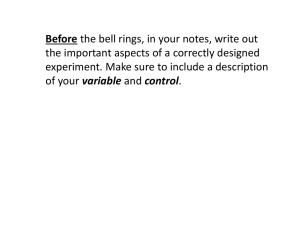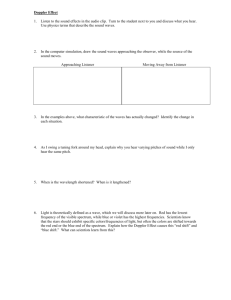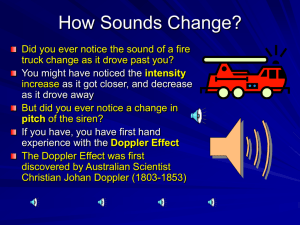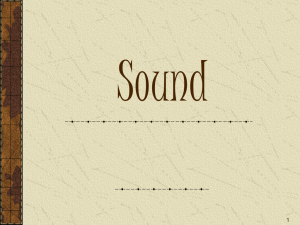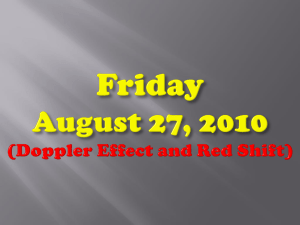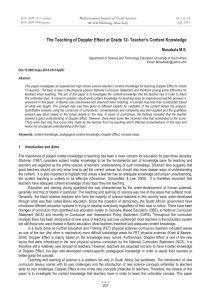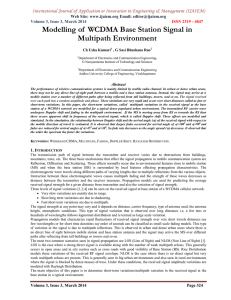The Doppler Shift (PowerPoint)
advertisement
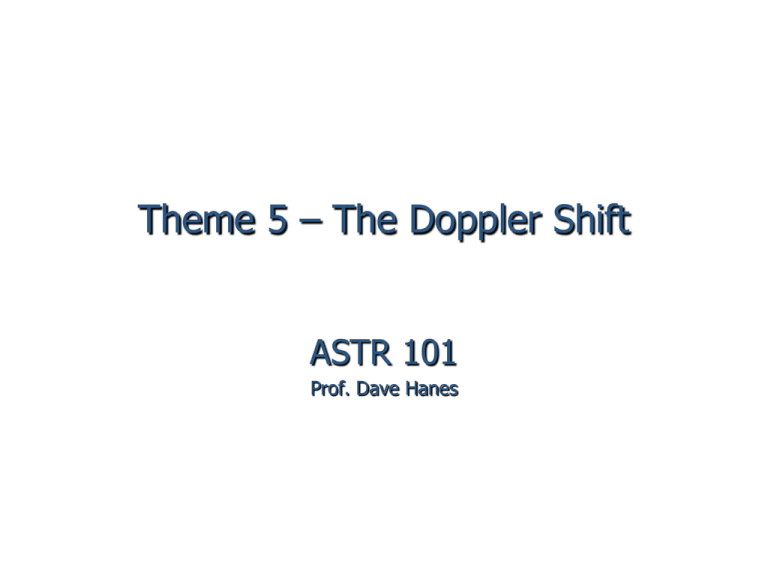
Theme 5 – The Doppler Shift ASTR 101 Prof. Dave Hanes The Surfer’s Experience Waves come in to shore perfectly regularly. If you float in place, you bob up and down as each wave passes – say, once every 5 sec If you paddle out towards the incoming waves, you meet each wave sooner than expected, so your frequency of bobbing up and down increases – perhaps once every 4 seconds Think of Sound The ‘wavefronts’ reach your ear with a regular frequency. But if you walk towards the speaker, successive waves hit your eardrum a little sooner than expected, so they arrive with a higher frequency than expected. Your eardrum is set vibrating at a higher frequency than if you were at rest! The tone sounds higher in pitch than if you were at rest. Turn The Thinking Around If the surfer now paddles towards the shore, the waves affect her with reduced frequency. (In the limit, she ‘rides a wave’ and experiences no up and down motion at all!) If the listener walks away from the speaker, the sound waves arrive less frequently, producing a lower-pitched sound. Moreover, it does not matter if the listener is moving and the speaker at rest, or vice versa. Relative motion is the key! If the distance between them is shrinking, the perceived frequency is increased; if it’s growing, the perceived frequency drops. The Doppler Effect in Words Any periodic effect will be: Perceived at higher frequency if the distance between the source and the receiver is decreasing Perceived at reduced frequency if the distance between the source and the receiver is increasing A Direct Test: Sound Doppler proposed a test: an open train car with trumpeters playing a note of constant pitch. Other musicians with ‘perfect pitch’ stood beside the tracks to see if the note sounded ‘too high’ as the train approached. This was successful! http://www.planetseed.com/relatedarticle/doppler-effect-train Common Misunderstandings If you know the expected pitch, and you hear a note that is “too high,” you know instantly that the source is approaching. You don’t need to hear it again later to see if anything changes. One hearing is enough! The familiar up-and-down wailing of a siren is not the Doppler shift! (Is the source alternately coming towards you and moving away? No!) But here’s a link where we hear that wailing (produced by the siren itself) and then an overall drop in pitch as the fire engine passes by (so it is no longer approaching you but receding). https://www.youtube.com/watch?v=imoxDcn2Sgo What is Light? You are right: it’s a wave, the crests of which reach you with a certain frequency. By Doppler’s reasoning, if you are moving towards a source of (say) red light, you should perceive a higher frequency – the light should look somewhat bluer. And conversely: a receding source should look somewhat redder. (This is true whether it is you or the source that is ‘actually moving.’ Relative motion is the key.) A Losing Argument You run a red light, but tell the traffic policeman that you perceived it as green because you were approaching it. This would require you to be travelling at a considerable fraction of the speed of light! So you get charged with speeding instead. One Problem Doppler first applied this reasoning to stars. Some binary stars have a red and a blue star side by side. He proposed that the colours might be due to their motions – the blue one approaching us, the red one moving away. But the speed of light is so high, and the velocities of the stars so small, that only imperceptible colour changes could ever arise. (As you now know, the difference is because of different stellar temperatures.) Apparently Hopeless As noted, the colours of stars are too little affected by the Doppler shift to be noticeable, since their velocities though space are so small (perhaps a few hundred km/sec) compared to ‘c’ (300,000 km/sec). Moreover, even if blue light in the spectrum were to be shifted to (say) green, previously invisible ultraviolet light will be shifted to blue, making up the loss. All in all, you expect no pronounced effect, and indeed this is hopeless for determining velocities. Easy With Emission Lamps! Someone turns on an emission lamp. The spectrum might look like this (one blue, one green, one red line): Suddenly, in a fit of rage, they hurl it at your head at very high speed. To you, the spectrum now looks like this: Because you can identify several discrete lines, the shift towards the blue/violet end is actually noticeable! (even for modest velocities). Towards and Away Same Principle for the Stars Instead of looking at the overall colours of the stars, we look for displacements in the absorption lines. Measuring those displacements gives us the velocities of the stars relative to us. Note that one measurement only is required to figure out the instantaneous velocity – there’s no need to “do it again later and look for changes.” Note also that this does not tell you anything about the sideways motion of a star – only its motion along the line of sight (the so-called radial velocity). Applied Here First, we use an emission lamp at rest in the observatory to tell us what colour / wavelength / frequency each line should be, then compare the star’s spectrum to that. We don’t need to see the colours, by the way! We note that the absorption lines are shifted to the blue end (shorter wavelengths, higher frequencies.) This tells us that the star is approaching (or that we are moving towards it). And we can determine that velocity! Arcturus Remember that the radial velocity signifies only the relative motion – it could be the Earth or the star moving (or both). Here’s the spectrum of Arcturus in June And here it is in December Compare These in Detail We see a change in the Doppler shift, implying a change in velocity from June to December. This behaviour repeats, year after year. Is Arcturus moving back-and-forth in our direction? NO! In this case, we are noticing the back-and-forth motion of the Earth towards and away from Arcturus as we orbit the Sun. The Doppler shift told us about the relative motion. Radar Guns and Sunlight In the Solar System, we can use the Doppler effect as well, in one of two ways: Like a policeman, send out actual radar signals. This is a radio wave of a fixed frequency that gets shifted to a higher or lower frequency if the object off of which it reflects is moving towards or away from us Use the Sun as a source (a ‘radar gun’)! When its light reflects from an object, we see a Doppler shift in the absorption lines in the solar spectrum depending on how the object is moving. Applied to Saturn’s Rings Look at the sunlight reflected from various parts of Saturn. The planet itself rotates as a whole, with the outer edges moving fast (one towards us, the other away) The rings are different. The inner edge of the ring moves faster than the outer edge! This would not be possible if it were solid, like a frisbee. The rings are evidently made of small lumps, like millions of tiny moons in parallel orbits.
